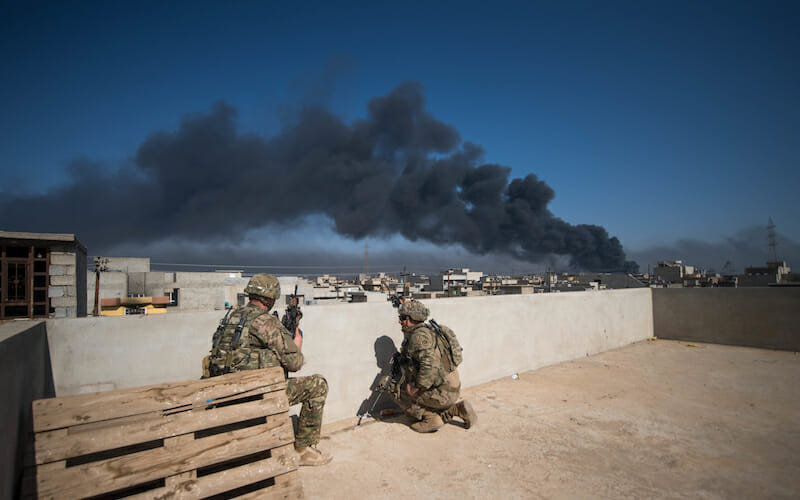
It Is Time to Pull Back in Syria
The conflict in Syria is becoming more dangerous for U.S. forces. The stated objective of destroying the Islamic State in Iraq and Syria, or ISIS, is essentially achieved. With the justification for U.S. presence receding, and the chaos in Syria reaching a crescendo, it is time for the United States to begin reducing its presence in Syria.
It would be an understatement to call the Syrian Civil War complex. Multiple rebel groups vie with the Syrian government and each other for control of territory. These rebel groups are far from homogenous. They include Kurdish dominated factions, Al-Qaida linked factions, less radical Sunni factions and, of course, the infamous ISIS. ISIS catapulted the conflict to a global issue when it expanded the war beyond the borders of Syria invading Iraq and nearly routing the Iraqi Army. With the advent of ISIS, the United States, Russia, and Iran all involved themselves in the conflict. Turkey and Israel both watched the conflict warily but until recently chose not to involve themselves.
In the opening months of 2018 the barriers that kept outside powers from openly clashing began to break down. Turkey invaded Syria in order to destroy a Kurdish enclave in Afrin and is threatening action against other Kurdish controlled territory. Israel shot down an Iranian drone and then conducted airstrikes against Syrian and Iranian targets. During that airstrike Syrian Government forces shot down an Israeli F-16. On February 7, pro-Assad Forces attacked a Syrian Democratic Forces (SDF) position where U.S. forces were stationed. The attack did not kill any U.S. forces, but U.S. airstrikes killed over 100 pro-Assad forces, including several Russian mercenaries.
U.S.-backed forces have nearly destroyed the ISIS. The United States began its involvement in Syria because ISIS’ presence there posed a threat to the United States and its allies. While ISIS may have moved elsewhere, to places such as Egypt or Libya, U.S. and allied efforts marginalized them in Syria and Iraq. The United States needs to take this victory and avoid overreaching by getting further involved in the Syrian civil war.
ISIS acted as a mutual antagonist for the competing forces in Syria. As long as everyone could say that they were there to fight ISIS, they had a reason to avoid conflict with each other. Without ISIS, groups such as the SDF will increasingly come into direct conflict with the Syrian government, and by extension Russian and Iranian forces. Because U.S. forces operate with the SDF, the chance of direct conflict between U.S. forces and Russian and Iranian forces will only increase.
Rival forces in Syria are acting more aggressively towards U.S. backed forces. The February 7 engagement between U.S. and SDF forces against Pro-Assad forces and Russian mercenaries is a clear warning of things to come. No U.S. or uniformed Russian military personnel died in this incident, but the risk is growing. Russia and the Syrian Government have used the threat of ISIS to justify attacks on non-ISIS and may use this justification to attack U.S. supported SDF positions again. The end of ISIS is not the end of the Syrian Civil War, especially for the Syrian Government and its backers. It is unrealistic for the U.S. to expect that the Syrian Government and its backers will accept an autonomous SDF controlled region.
Current U.S. policy is alienating Turkey, a key regional ally. Currently, the United States openly supports the SDF. Kurdish People’s Protection Units, also known as the YPG, make up the majority of the SDF. The Turkish government argues that the YPG is an offshoot of the Kurdistan Workers Party, also known as the PKK. Both Turkey and the United States consider the PKK to be a terrorist group. In fact, Turkey sees the PKK as an existential threat due to a decade’s long insurgency fought by the PKK against the Turkish government. In January, the Turkish Army began operations against SDF forces in the SDF enclave of Afrin, where, fortunately, there are no U.S. forces. Turkey is also threatening to attack SDF controlled Manbij, where there are U.S. forces. The longer that U.S. forces stay in SDF controlled areas, the greater the risk that Turkey, a NATO ally, will kill U.S. soldiers or force U.S. soldiers to kill Turkish troops in self-defense.
The United States needs to ask itself why it is in Syria after the defeat of ISIS. If the United States remains in Syria to back rebel forces, it will inevitably lead to conflict with Russian, Iranian, and Syrian Government forces. If the United States remains in Syria to support the Kurdish forces, it will lead to conflict with or alienation of Turkey. None of these outcomes benefits the United States. Nor do they support stated U.S. objectives. As ISIS disappears from Syria so too should the U.S. presence.

